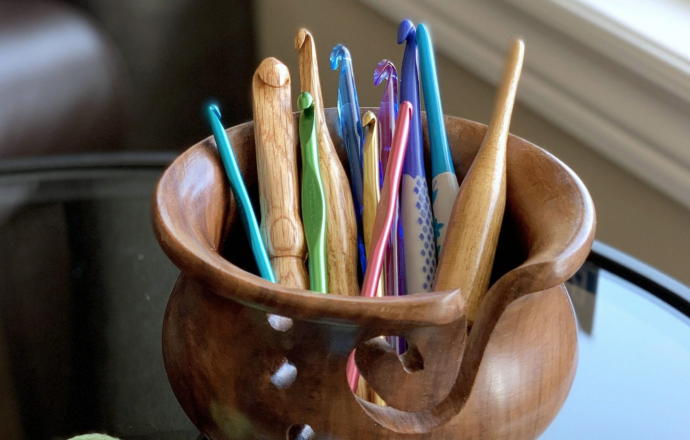Crochet Essentials: Hook Sizes & Tips
Most crochet hooks are a similar shape, but they come in many different materials. One of the hardest things when I first started to crochet was keeping control of my yarn. For this reason, I highly recommend bamboo, wood or plastic crochet hooks to start. The good news is, plastic and bamboo crochet hooks are quite inexpensive and can be found in a lot of dollar stores. Anyway, which type you use is up to you. Some people prefer the warm feel of wood or bamboo; others prefer the cheaper metal ones – try various types to find your favorite. But what is really important here – it choosing the right hook size.
Why? If you choose the wrong crochet hook, you might end up with a sweater that is much smaller or larger than intended.
A hook’s size is the diameter of its shank, and it is this that determines the size of the stitches. Most yarn-ball information and patterns will tell you which hook to use, but you will soon come to know which size works best with which yarn. If you want a tighter, closer stitched result, you can use a slightly smaller hook; for a looser weave, use a larger hook. Eventually you will amass a collection of different-sized hooks to enable you to work with any type of yarn.
Check the yarn ballband and the pattern to choose the right size.
There is usually a recommended hook size for each yarn weight identified on the yarn ballband or in the pattern, if you are using one. Your crochet pattern will tell you what hook size the designer used. You should start with this.
Are you a crochet newbie? Then, please do yourself a favor and go for projects that use a bigger crochet hook. This will save you so much hassle until you get the basics under your belt. Really! Larger hooks create bigger stitches, all the easier to see where you are and where you're going.
The hook tip
Some hooks have short shafts which can make it more difficult to crochet cluster stitches, or very rounded tips which can be hard to insert through your stitches. Others might have very pointy tips which could split your yarn. On the other hand, an extra pointy tip can come in handy if you need to insert through tightly worked fabric. It’s simply a matter of choosing what suits you and the project you’re working on best. If it’s your first hook, go for something in-between all the extremes on offer.
Never Switch Hooks
Note the brand, model, and size of the hook you are using at the start of a project. Keep a record of it in case you lose the hook. You want to be able to replace it with the same exact hook. One quick way to do this is to take a photo when you begin a project and email it to yourself with further notes. This is always smart at the start of a project anyway so that you have a good record of what you've made.
Once you've started a crochet project, be sure to keep using the same crochet hook you started with. Do not think that switching hooks is acceptable just because you have several of the same sizes in different brands.
Buy multiples of your favorite crochet hook. Once you have one that you love to use, you should make sure that you have extras in case it ever gets lost or broken!
If your crochet work is consistently too tight, or too loose, try crocheting with hooks made by a different manufacturer to see what effect they may have on your work. You can also try different hook sizes as well.
Take care of your hooks
A purpose-made hook roll can protect your hooks from damage and allow you to see them all clearly when selecting one. Wooden hooks may need occasional treatment with linseed oil, while metal or plastic hooks will sometimes need wiping with a damp cloth to keep them clean and free from grease. Use a bag to store your ongoing projects, so that all you need is kept together in one place and portable.
Tip: a mystery hook
Fortunately, most hooks are marked with their size, usually on the thumb rest or at the bottom of the handle. But if you find a hook with no indication of its size, you might be tempted to stick it through a device called a gauge check made of plastic or metal with holes in it. If the head is big, as it is with the round head, the head will not go through the hole of the proper size. For these hooks, try comparing the size of the shaft of the mystery hook to an existing hook whose size is labeled. Roll them together between your fingers and compare them.
Hope this information is helpful for you. Have you ever had troubles with choosing the right hook or using the wrong one?


I'm pinning this for others that may need to know these things.
A lot of good advice here🙂